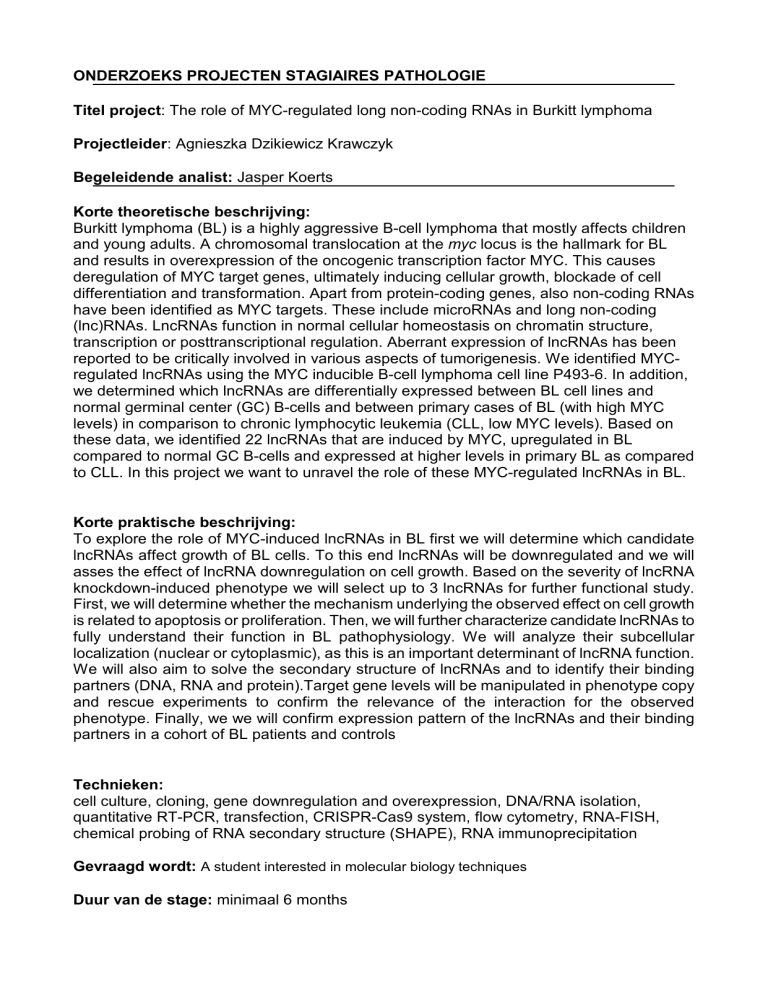
ONDERZOEKS PROJECTEN STAGIAIRES PATHOLOGIE
Titel project: The role of MYC-regulated long non-coding RNAs in Burkitt lymphoma
Projectleider: Agnieszka Dzikiewicz Krawczyk
Begeleidende analist: Jasper Koerts
Korte theoretische beschrijving:
Burkitt lymphoma (BL) is a highly aggressive B-cell lymphoma that mostly affects children
and young adults. A chromosomal translocation at the myc locus is the hallmark for BL
and results in overexpression of the oncogenic transcription factor MYC. This causes
deregulation of MYC target genes, ultimately inducing cellular growth, blockade of cell
differentiation and transformation. Apart from protein-coding genes, also non-coding RNAs
have been identified as MYC targets. These include microRNAs and long non-coding
(lnc)RNAs. LncRNAs function in normal cellular homeostasis on chromatin structure,
transcription or posttranscriptional regulation. Aberrant expression of lncRNAs has been
reported to be critically involved in various aspects of tumorigenesis. We identified MYCregulated lncRNAs using the MYC inducible B-cell lymphoma cell line P493-6. In addition,
we determined which lncRNAs are differentially expressed between BL cell lines and
normal germinal center (GC) B-cells and between primary cases of BL (with high MYC
levels) in comparison to chronic lymphocytic leukemia (CLL, low MYC levels). Based on
these data, we identified 22 lncRNAs that are induced by MYC, upregulated in BL
compared to normal GC B-cells and expressed at higher levels in primary BL as compared
to CLL. In this project we want to unravel the role of these MYC-regulated lncRNAs in BL.
Korte praktische beschrijving:
To explore the role of MYC-induced lncRNAs in BL first we will determine which candidate
lncRNAs affect growth of BL cells. To this end lncRNAs will be downregulated and we will
asses the effect of lncRNA downregulation on cell growth. Based on the severity of lncRNA
knockdown-induced phenotype we will select up to 3 lncRNAs for further functional study.
First, we will determine whether the mechanism underlying the observed effect on cell growth
is related to apoptosis or proliferation. Then, we will further characterize candidate lncRNAs to
fully understand their function in BL pathophysiology. We will analyze their subcellular
localization (nuclear or cytoplasmic), as this is an important determinant of lncRNA function.
We will also aim to solve the secondary structure of lncRNAs and to identify their binding
partners (DNA, RNA and protein).Target gene levels will be manipulated in phenotype copy
and rescue experiments to confirm the relevance of the interaction for the observed
phenotype. Finally, we we will confirm expression pattern of the lncRNAs and their binding
partners in a cohort of BL patients and controls
Technieken:
cell culture, cloning, gene downregulation and overexpression, DNA/RNA isolation,
quantitative RT-PCR, transfection, CRISPR-Cas9 system, flow cytometry, RNA-FISH,
chemical probing of RNA secondary structure (SHAPE), RNA immunoprecipitation
Gevraagd wordt: A student interested in molecular biology techniques
Duur van de stage: minimaal 6 months
Informatie:
Universitair Medisch Centrum Groningen
Afd. Pathologie en Medische Biologie
Sectie Pathologie
Mirjam Mastik
Hanzeplein 1
9713 GZ Groningen
tel 050 3610670
email:[email protected]

